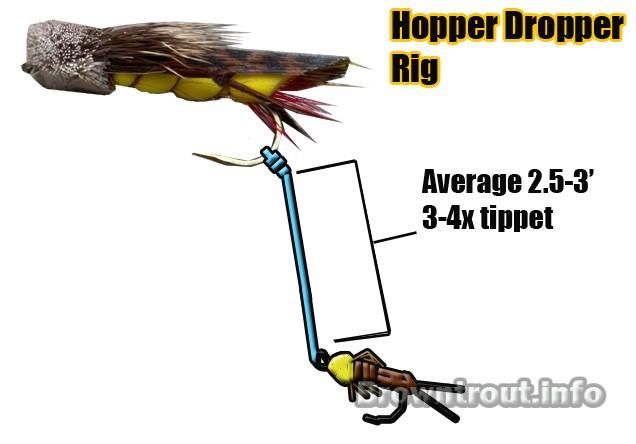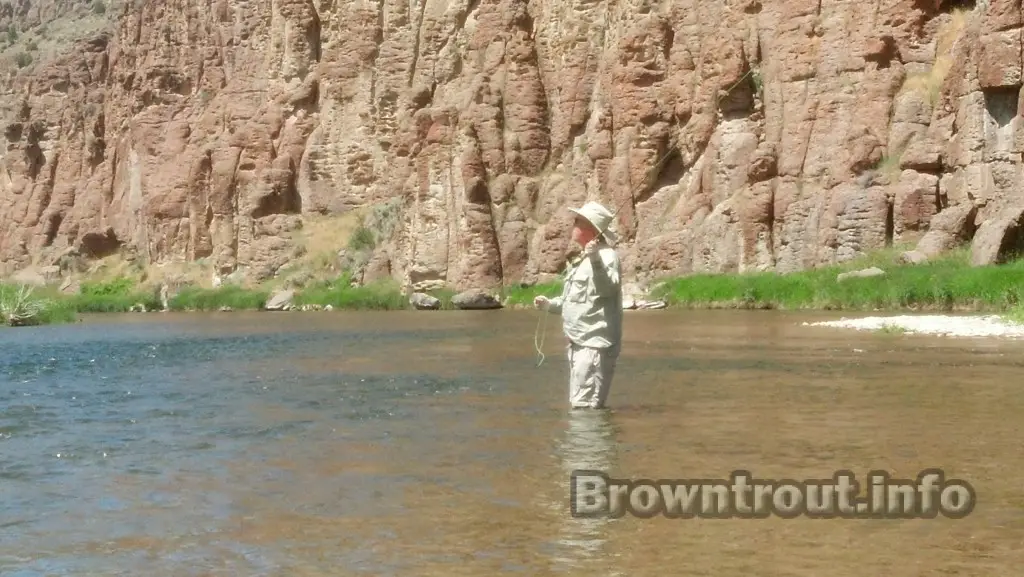This post was last updated on August 5th, 2021 at 03:09 pm
The Hopper Dropper rig is very effective rig for trout fishing all summer long. This wonderful rig will allow you to get the best of both worlds; both dry fly and nymph fishing simultaneously.

Hopper Season! Learn How to Use the Hopper Dropper Rig Effectively for Fly Fishing Summer Trout
We all have those days in the summer where you know there is the opportunity for a big fish to come up to the surface and eat a hopper, but most of the fish are not actively feeding on the top. The best way to maximize your catch is to employ both the dry fly hopper and your nymphs a short ways under the surface. We would almost all prefer to see a massive trout come up and eat the hopper, but it just doesn’t always work out that way. This is also an very effective rig during the salmon fly and golden stone hatches. Any fly large enough to float nymphs will do the job.
How to Tie a Dropper Fly Fishing – Rigging a Hopper Dropper
You will need to ensure that your hopper is capable of holding up the weight of the nymph, so try to use a hopper or chernobyl ant that is made with thick foam. I will usually use the thickest and most buoyant foam available to tie my flies with. By using ultra thick foam you will usually be able to float multiple nymphs with no trouble at all. Personally I try to limit my nymphs below a chernobyl ant or hopper to 1 or 2. More than two nymphs can become a big mess in a hurry once you hook a fish (especially when it eats the hopper). Most areas it would be against the law to use more than 3 hooks anyway, so be sure to check your local regulations before employing this deadly strategy on your local trout population.
Tying the Proper Size Tippet to the Bend of Your Hook
Tie your 3x or 4x tippet to the bend of your hoppers hook. I usually use anywhere from 1 foot to 5 feet dependent upon the depth I think the fish are. My standard length is 2.5 feet using 3x tippet. I use the clinch knot for this particular tie.
Tip: If you are using very light or weightless nymphs you will be better off using lighter tippet. The lighter and thinner 4x-5x will cut the water and allow your nymphs to sink faster. Using 3x and a weightless nymph will take (dependent on your rivers current) up to 15 feet of drag free drifting to get down to its maximum depth (because of the extra surface area of the heavy line).
Using a Multiple Nymph Hopper Dropper Rig
To use more than one nymph you will simply need to tie and extra 12″ of tipper to the bend of your first nymph. I try to make the distance between the first and second nymph about 50% of the length of the first bit of line coming off the hopper or chernobyl ant. For example if I use 3 feet of line between my hopper and nymph #1 then I will use approximately 1-1.5 feet of line between nymph one and two.
Tip: Always try to place your heaviest nymph at the highest position on your rig and get smaller with each nymph. This will limit the amount of tangles. So from heaviest to smallest in that exact order will ensure your flies lay out and roll properly with minimum problems. This is sort of the same effect that a tapered leader has to your casting.
Picking the Best Nymphs for Hopper Dropper Rigs
If you are fishing in an area with slow current and shallow riffles you will be able to use some very light nymphs. Beware that at the end of most riffles will likely be a drop off, and you should choose a weighted nymph for those areas. In faster currents, you will need a heavy nymph on your hopper dropper rig to get down quickly in order to catch the most trout.
How Do You Fish with Hopper Droppers?
Treat your fly fishing hopper the same way you would treat a strike indicator or bobber. That means proper mending and no dragging flies. If your floating fly is dragging, that means your nymphs are never getting to the proper depth because they are being trolled by the floater.
Don’t think that you are going to see your hopper dropper rig or chernobyl ant go shooting under the water like a rocket when you get a hit. These fish are not going to eat the nymph and go swimming off, they will eat it and sit there waiting for more. Don’t expect alarms and bells to go off telling you you have a strike, because 99% of the time it will be very subtle. Usually you will have about 1-2 seconds to set the hook before the fish spits the fly, so there can be no hesitation! You yourself a favor and don’t be that guy who thinks every actual strike is the nymph bumping rocks, because you won’t ever hook fish that way. If you see your dry fly even move 1 inch set the hook. The person who sets the hook on every movement of the fly WILL be the one who hooks the most trout using the hopper dropper.

